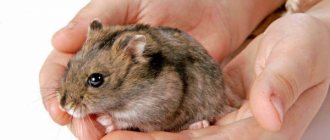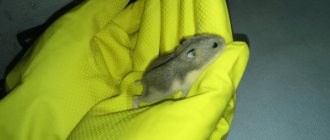At home, breeding of Syrian hamsters can occur all year round. But before you start breeding rodents, owners should learn all the intricacies of this difficult matter. After all, in order to ensure the production of healthy offspring, it is necessary to know the rules for selecting pairs, choosing the time for mating, and the features of feeding, care and maintenance of pregnant females.
Peculiarities of reproduction of domestic rodents
Domestic rodents of the Hamyakov family are characterized by increased fertility. In a year, a female can bear up to 10 offspring. One litter is from 12 to 18 hamlets. And this is not a myth, but a fact! After mating, the female can become pregnant the next day. Just imagine how quickly everything happens in these mammals. All this is actually possible if the animals are provided with all the conditions for full-fledged living and reproduction.
There are some nuances that any livestock breeder needs to take into account in order for domestic hamsters to fully reproduce:
- Under no circumstances should you mate animals of different breeds;
- you should also not pair a sister with a brother, since the resulting offspring will not be viable;
- To avoid closely related relationships, it is recommended to buy a female and a male from different pet stores.
Puberty
Let's start with the most important thing - what time do hamsters begin puberty? The ability to reproduce in females and males begins at different ages. Reproductive individuals mature by 1.5 months. The ability to fertilize in males begins at three weeks of age.
It is very important to prevent the mating process until the formation of the skeleton and all organs of domestic rodents. Djungarian hamsters whose breeding is carried out ahead of time can give birth to underdeveloped offspring, after which the mother can even eat it.
The best period for the first mating is when hamsters are between four and six months old. Repeated mating is carried out no earlier than 2 months after the first. Two months is enough for the animal to fully recover after pregnancy and childbirth. Some livestock breeders do not allow the male to approach the female after mating for 3-4 months.
The female has the ability to give birth to children until she reaches 1.5 years of age. Males retain reproductive function throughout their lives. After the first fertilization, five weeks later, the male can be placed with a new female. Earlier than the specified period is not recommended, since the male remains weak and is not able to fertilize the female.
Conditions of detention
For breeding, it is very important in what conditions the rodent is kept, and you should worry not only about the room temperature and silence
It is also necessary to pay attention to the filling of the cell. The area of the bottom of the cage must be at least 50x30 cm
This will give the rodent space. The bottom of the cage should be covered with compressed sawdust, granules or corn filler. The litter is filled with a thickness of at least 1 cm.
You need to put a house in the cage, the hamster will hide in it. Rodents use houses not only as a bedroom, but also as a storage room. The birth of offspring often occurs in it too. You can notice where she plans to give birth to cubs by following the female. She will begin preparing the nest even before giving birth. The owner can also help with the arrangement. To do this, just tear an ordinary white napkin into pieces, which you leave in front of the entrance to the house. Your pet will definitely use them for decoration. Water for a pregnant hamster should be fresh and in a remote drinking bowl. The presence of water is vital for the female during pregnancy. Regularly check rodent supplies to ensure they do not consist of perishable products.
A pregnant pet should be kept active, that is, purchase special accessories for running.
Provide unobtrusive care to a pregnant female and soon you will be enjoying little hamsters in your home.
All Syrian hamsters are capable of producing offspring in captivity. Reproduction is a very responsible and important moment for those who decide to have a rodent at home. It is necessary to provide proper care and concern for the female and her offspring. The offspring that are born will grow up healthy and bring joy to you and your children. By presenting small, healthy hamsters as a gift, you will pleasantly surprise and greatly delight your friends and family. In this article we will look at preparing for breeding and caring for hamsters during and after birth.
How to determine heat
Catching the moment when female hamsters begin to hunt is important for successful mating and further reproduction. If the hamster is not in heat, mating can lead to a fight and injury to both individuals. Hamsters come into heat every fifth day and last only a day. This period in the female is accompanied by mucous discharge.
Some obvious signs will help to determine for sure a change in the hamster’s body:
- presence of musky odor;
- appetite decreases sharply;
- restless behavior;
- when stroking the back, the female begins to bend and raise her tail;
- calm reaction to the male.
Under unfavorable conditions at home in females of mature and young age, estrus may disappear. This often happens when your pet is frequently hypothermic.
A few words about the kids
Newborn hamsters develop quickly and learn about the world. But for the first week they do not leave the nest at all, feeding on the milk of their furry mother. Breastfeeding lasts from birth to 3 weeks. During this period, it is better not to touch the animals, because a hamster may lose milk due to stress, and an angry mother in labor may abandon her babies altogether. In this case, you will have to feed the hamster offspring yourself, and many of the babies will die.
To prevent this problem from arising, provide the family with peace for the first 2 weeks. The bedding is also not changed during this period, but only a little food is added. At one week of age, babies begin to crawl blindly around the cage. And already at the age of 2 weeks they open their eyes. Around this period, complementary foods consisting of low-fat yogurt and peeled seeds should be introduced.
At 3 weeks, babies are already covered with thick fluff and can eat on their own. This means that it is time to remove them from their mother. Watch the babies for another week, and already at the age of 1 month you can give the miniature animals to new owners.
If you decide to keep the kids for further breeding, then at the same age determine their gender and place the boys and girls in different cages. This precaution will not allow the reproduction of small rodents to take its course.
There are many nuances in the reproduction of hamsters. You need to remember that mating of animals must be timely, voluntary and safe for both participants. At the slightest sign of aggression, separate the animals from each other! An important aspect of reproduction is the gestation period. In this position, the pet needs absolute rest and increased nutrition.
Source
Rules for breeding hamsters
A neutral design is best suited for mixing hamsters. In someone else's cage, hamsters will not behave aggressively towards each other. So the instinct to preserve their own home will be absent in hamsters. It is better if you place the rodents in a cardboard box. It will make it easier to remove the fluffies in case something goes wrong. If you do not have this opportunity, then it is recommended to place the female with the male, but in no case vice versa.
During the mating process, do not leave the hamsters alone. Your presence is necessary to monitor the mating process and ensure that it was successful.
Some livestock breeders prepare the couple in advance by letting them out for a walk together, but in different walking balloons. Other livestock breeders place animal cages next to each other 1-2 days before mating.
In hamsters, reproduction will be successful only if the female is in heat on the day of breeding. For the owner, this is a signal that it is time to bring the animals together.
Pros and cons of breeding Syrian hamsters
Breeding Syrian hamsters cannot be considered a profitable business that provides a stable income. In addition, the reproduction of rodents is associated with a number of difficulties and inconveniences.
It is worth highlighting several arguments against rodent breeding:
- Material costs for feed enriched with calcium and vitamins, cages, additional volumes of bedding.
- Negative effects of reproduction on the body of females. Reducing their life expectancy by 1-2 years.
- Time spent on maintaining cleanliness in the cages, preparing food, seating and taming young animals, and finding new owners for the babies.
- Contact a veterinarian if problems arise with the health of the mother and cubs.
- Disappointment and moral trauma in the case of a female eating her offspring.
You should also take care in advance about selling small Syrian hamsters to give the mother the opportunity to recover and prepare for a new pregnancy. After all, if you do not analyze the market for the sale of offspring, you may have to keep the babies for a certain time.
Hamster mating process
So, how do hamsters reproduce at home? The entire mating process lasts about half an hour with short breaks. In some cases, animals only need five minutes to complete the fertilization process. It is not recommended to keep a male and a female in the same cage for more than an hour. If mating does not take place during this period of time, then breeding of hamsters needs to be postponed for some time.
You can determine that a female is ready to mount by her behavior and posture. If she stands still, legs spread and tail raised, then she is ready for fertilization.
Like other pets, hamsters do not always have a successful first mating. If a few days after mating the female goes into heat, then this procedure needs to be repeated.
Unsuccessful reproduction of hamsters the first time is possible if a young and inexperienced male is placed with an adult female. You need to make several such additions, and then the young hamster will get into the swing of things.
Breeding rules
It is important for the future hamster breeder to know that the story about their fertility is a kind of myth. These animals are evolutionarily solitary. If you want to breed them, you will have to take into account many nuances. For example, they cannot be planted in the same cage initially.
Hamsters are conflict animals; they will fight until death.
How long do Syrian hamsters live at home? Not as much as I wanted. We can say that increased fertility is directly related to short life span. A peculiar protective mechanism of evolution that protects a species from extinction.
Therefore, two rodents of different sexes are not enough for reproduction. You will need two cages with dwellings. This rule does not apply to Roborovsky hamsters. This species lives in large groups. When breeding them, you get the other extreme: a flock will require a large cage with enough space for each individual. Otherwise, fights will begin for free space. According to the recommendations of experienced breeders, this type of hamster is ideal for trial breeding.
Breeding the popular Djungarian hamsters will require a lot of effort and investment (like almost all rodents). You will need several cages: separate ones for adult males and females, another one for the grown litter (1–2 months), and then several more for housing the young animals without exception.
The breeder needs to remember that hamsters, regardless of breed, will breed 3-4 times a year. This is not the limit, but a larger number of litters will have a bad effect on the condition of the female. Therefore, immediately after giving birth, it is better to move the male into his cage. You also need to be prepared for the fact that the hamster may destroy some of the offspring if it realizes that it cannot feed everyone (this is natural for rodents).
Why don't hamsters reproduce?
There are several factors that reduce the reproductive function of domestic rodents. If you want your hamsters to reproduce fully, here are some very important tips:
- Obesity is one of the most common problems. It is quite easy to identify such a female. She will be inactive due to her weight, her legs are barely visible under the folds of fat, her belly touches the floor. To avoid such consequences, you need to equip the cage in advance with all possible attributes for increased activity of the rodent.
- Violation of the reproductive function of animals can cause imbalance in nutrition. From a lack of nutrients, hamsters become infertile.
Hamsters have a high reproduction rate. It is known that wild hamsters can produce offspring equal to a hundred individuals in just 7-8 months. Therefore, having made such a serious decision, it is important to take care of where you can place or sell the grown-up cubs. However, you should not breed hamsters at home often; this can greatly harm the health of both the female and the male.
Arguments against reproduction
Breeding Syrian hamsters is a very costly endeavor, both in terms of time and finances. It is necessary to provide animals with high-quality and healthy food, and purchase comfortable and spacious cages. Get a supply of clean sawdust and filler. And of course, you need to pay a lot of attention to the female and young animals at this time. Monitor the health of the offspring and, if necessary, contact a veterinarian.
You should also give up the idea of breeding if your pet is already over 15 months old. At this age, she may die during childbirth. A small body structure and low weight can cause pathology during pregnancy and childbirth. In addition, the female lives longer if she does not give birth, since each birth depletes her body by a third.
Great stress will be the fact that the female can kill her offspring, sensing danger or at a moment of stress.
How to breed hamsters. Preparing the female and male.
- The first thing to remember is that future parents should always live separately from each other. Otherwise, it could be fatal for one or both animals. Same-sex hamsters will also not get along together.
- If you are going to breed small hamsters, do not mix up the breeds. The Djungarian breed and the Campbell's hamster are very similar to each other, but serious problems may arise during crossing, and you may lose the female.
- It is important to provide throughout their hamster's life. If you feed, especially a female, just anything, this can lead to non-viable offspring, or she will eat them after birth. During pregnancy and nursing hamsters, the female needs to be given protein food more often, about every other day.
- Now separately about the females. They reach sexual maturity at two months, but this is too early an age for mating, since the body is not fully formed. Ideal age is 4 months. But you shouldn’t wait until six months. At the age of 12-13 months, females lose their ability to reproduce.
- In order to prevent wear and tear on the female’s body and get healthy offspring, it is necessary to observe pauses between matings of three months. It turns out that from one hamster you can get offspring three, maximum 4 times.
- Males. It's a little easier with them. They reach sexual maturity at 5 weeks and until the end of their lives. It is recommended not to breed the male too often so that the hamster does not lose its fertility.
How do Syrian hamsters reproduce?
Most hamsters reach sexual maturity at 6 weeks of age, although some can breed as early as 21 days old. It should be understood that at such an early age the offspring will be quite weak, since the animal’s body is not fully developed.
Pregnancy in young females often provokes the appearance of rickets and other complications both in her and in the offspring. Very often, females who become pregnant at the age of several weeks completely eat their offspring. Thus, it is best to mate hamsters when they reach 5-6 months of age. It should be understood that it is necessary to fit into these terms, since at a later age pregnancy can cause complications in the female.
Did you know? European hamsters are considered the largest representatives of their species. Adults reach 35 cm in length.
Experts say that at least 3-4 months must pass between two matings, during which the female has time to regain strength after the previous pregnancy. Without such an adaptation period, subsequent offspring are very weak or may not survive at all. It is best that the second mating occurs already at the 10th month of the female’s life, since closer to the age of one year she may partially lose the ability to reproduce. As for males, such problems do not arise with them: the possibility of mating appears already at the age of one month, in addition, they retain the ability to produce offspring throughout their lives.
Stages of breeding hamsters at home.
There is no need to breed hamsters and other rodents just like that. Both females and males will live just fine without breeding for their entire hamster life. The absence of cubs will not harm them in any way. Estrus in females is usually painless.
For some people, breeding hamsters is a business. Others conjure genetics, putting their soul into the nursery. Still others had no intention of breeding hamsters at all, but got offspring by accident.
Knowing at what age hamsters begin to mate, the breeder must have time to place the young animals in different cages according to gender.
The optimal period for the first mating is from 4 to 6 months. Second mating – 8-10 months (for the female). The animal is allowed to recover after birth for at least 2 months, and preferably 3-4 months.
Hamsters reproduce until they are 1-1.5 years old, after which the female loses the ability to give birth.
Males retain reproductive abilities throughout their lives, and they can be bred as early as 5 weeks. But frequent mating is also undesirable - it exhausts the producer, and many females do not become pregnant after mating.
Childbirth
This is the final stage of reproduction of Syrian hamsters. On average they take from 2 to 6 hours.
At the beginning of labor, the female assumes a characteristic sitting position. During contractions, she curls up and pulls the cubs out of the birth canal with her teeth.
The time interval between contractions ranges from 5 to 15 minutes. During this period, hamsters:
- chew the amniotic membrane;
- gnaw the umbilical cord;
- licking a newborn baby;
- eat the placenta.
Important! During multiple pregnancies (more than 12), the babies are born at very short intervals, so the female does not have time to free all of them from the membranes, and some of the babies suffocate.
Competent breeders understand that frequent breeding has a negative impact on the health of Syrian hamsters. Therefore, after giving birth, the female is given 2-3 months to recover. She can bring 3-5 litters in a year. After this, the ligaments of the pelvic joint lose their elasticity, and labor in hamsters stops.
How do hamsters mate?
Hamsters mate several times with short breaks. The whole process takes 20-30 minutes, and sometimes even 5 minutes is enough for the animals. There is no need to keep the couple in the cage for longer than 45 minutes: if during this time the female does not allow the cage to be done, mating is postponed.
When the coquette is ready to breed, it stands motionless, with its hind legs spread and tail raised.
It can be difficult to mate with hamsters if the male is younger than his partner and inexperienced. But if you choose the right time, the fight may well end in intercourse. Hamsters do not always become pregnant after their first mating. If the female comes into heat after 3-5 days, she is bred again.
Mating of hamsters is a short process, but sometimes vigorous frictions weaken the animal, and the male lies motionless for some time.
Caring for Hamsters
After birth, during the first week, hamsters cannot be picked up. Having smelled someone else's scent on the cubs, the mother will most likely eat them. The desire to pet the babies should be postponed until the fur appears, which will happen in a week.
For the convenience of mother and babies, it is recommended to put a napkin or soft paper in the cage, with which the female covers the cubs when leaving them to eat. 5 days after birth, the cubs can already squeak demandingly; on the twelfth day of life, the hamsters begin to slowly crawl out of the nest and explore the surrounding space. Babies' eyes open only 2 weeks after birth, and around this time they begin to feed on their own. At this time, you can put a little porridge and carrots, grated on a fine grater, in the baby's cage. A healthy mother with a large amount of milk can feed her cubs for up to a month, and this has a positive effect on the health and strength of the hamsters.
How to breed hamsters
And for Syrians, it’s better on neutral territory, in a simple cardboard box. The absence of the need to protect their home cage reduces the likelihood of aggression, it is easier to place the animals (no need to catch them), and you can quickly get them if you see them fighting.
If there is no carrier, the female is placed in a cage with the male, but never vice versa. Given the nocturnal lifestyle, mating is carried out late in the evening.
Syrian hamsters should not be left unattended. This way you will make sure that it took place and avoid injury. It is also better to seat the Dzungarians after they stop paying attention to each other.
Sometimes it is recommended to move the cages for a few days to introduce a boy and a girl. Others let the animals run around together in walking balls. You should not humanize furry pets by arranging them on romantic dates.
The main condition is that the female is in heat. Then she will allow the male to mate with her.
Choosing a place to mate
For the breeding of hamsters to produce results, the couple in love must be left alone. The owners will only disturb the animals and distract them from their work. Many are worried that the boy and girl will not understand why they were put together. But this is stupid! In the wild, animals somehow find each other on their own and calmly reproduce. So why shouldn’t small pets cope on their own, because no one has canceled their instincts!
First, you need to find a cozy corner in your home where there will be no drafts, noise and threats in the form of curious pets. The marriage bed is placed there. It is best to keep hamsters not in a cage, where there are a lot of distractions (a wheel, other toys, food), but in a separate box made of thick cardboard or plastic. But it should be spacious enough, don’t forget to add filler. If you have a spare cage, that will work too.
So, you need to place two hamsters, a boy and a girl, in a love nest. At first, you can watch your pets and see how they get to know each other. If the hamster reacted favorably to the appearance of the gentleman, then move the box with the pets to where no one will disturb them. This is how hamsters of all breeds are reproduced.
The photo shows how the Dzungarians look closely at each other.
Hamster in heat
Determining in time that a hamster is entering heat is very important for successful mating. Otherwise, the animals will seriously harm each other in a fight. Hamsters come into heat every 4-5 days, lasting a day, and sometimes less. Sometimes owners wonder if hamsters have periods. Their reproductive cycle is completely different from humans, but the secretion of mucus accompanies estrus.
Signs of estrus in a hamster:
- a specific musky smell from the animal;
- anxiety, loss of appetite;
- in response to stroking on the back, it freezes and raises its tail;
- reacts loyally to the male.
External manifestations of sexual heat are clearly visible in Syrian individuals, but owners of dwarf rodents sometimes doubt whether hamsters are in heat. In Djungarian females, estrus can only be determined by their reaction to their partner.
Estrus may disappear in older individuals (1.5 years and older) or under unfavorable living conditions (low room temperature, little food).
Calculating the time of mating
The Djungarian hamster, Syrian and representatives of other breeds are crepuscular animals, which is why they prefer to breed at night. But not only the daily rhythms of these animals are important, but also the individual cycles of the female. While the furry Don Juan is ready to mate any day, the female shows sexual activity only during estrus.
Breeding hamsters at home depends on how correctly you calculate the time to introduce the male. But this is not easy to do, you have to seize the moment, because the female’s readiness lasts only 4-12 hours, and after that there is a break for 3-5 days. Typically, estrus begins in the evening, so you only have one night to mate your hamsters.
Here are the signs by which you can determine when a female is in heat:
- the pet becomes too active;
- small mucous discharge appears under the tail;
- often the mucus has a peculiar smell that attracts males;
- the hamster tries to bend her back, spreading her paws, while her butt and tail lift up a little;
- The female reacts loyally to the approach of the male.
Syrian hamsters very clearly display all of the listed signs, but girls of the Djungarian breed are more modest, so it is much more difficult to determine when they are in heat.
Why don't hamsters reproduce?
If, in the case of being kept together or having regular “dates,” the animals do not have offspring, there is usually a more reasonable explanation for this than “they didn’t like each other.”
Same-sex animals
Even if the seller assured you that it is a boy and a girl, you need to carefully examine the crotch area and. It is often discovered that two males or two females were required to produce children.
Obesity
– a common problem with Djungarian hamsters. Adipose tissue affects hormone levels and the female cannot become pregnant. Checking a dwarf pet is simple: when a fat animal sits, its paws are hidden under the folds, its stomach touches the floor when walking.
Hamsters are a pet that has a very typical breeding procedure. They have a natural tendency to mate every week. The months from April to October are known as the hamster's mating season. The most common breeds are the Syrian and Djungarian hamster, the reproduction of which is described here.
Syrian hamsters are inherently solitary, and this makes mating particularly difficult, as a female or male must only be introduced into another hamster's cage if the female is in heat to avoid serious fighting. Breeding Syrian hamsters requires patience from their owners.
Breeding Syrian hamsters requires patience from their owners
Estrus in domestic rodents
The female Syrian hamster goes into heat every 4 days (although this can vary from 3-5 days). At this time, she is more active and receptive to the attention of a man. Females come into estrus in the evening and can remain for 4 to 24 hours. Before this, the female usually emits a strong musky odor, and this is often noticeable during the summer months. The day after this, the hamster produces a thick white discharge from the vagina, and white discharge may sometimes appear in the urine.
During the winter, females may stop being in heat, and this can be helped by extending their daytime hours, turning on lights for 12 hours every day for a few days, and feeding vegetables.
Syrian hamsters should only be brought in for mating when the female is in heat. Even so, the male should not be introduced to the female on her territory, as she will be fiercely protective of her. The female should be introduced into the male's cage or she should be introduced into neutral territory.
It is best for mating to take place on neutral territory
If a female is suspected of being in heat, she can sometimes be "tested" by stroking her back towards her tail. The female will “freeze”, her body will be pressed to the floor, her head is directed forward, and her tail is in the air.
If there is any doubt as to whether the hamster is in heat, it is usually recommended to introduce rodents of both sexes into the cage so that they can be easily separated if a fight occurs. It is also wise to wear gloves or have a handy object that can be used to separate them if a fight does occur, as attempting to separate a female and male fight with bare hands is not recommended. If the female is not receptive to the male, she should be removed and repeated the next evening until she is receptive.
How do hamsters mate?
When introduced into the cage, the male should begin to fuss around the female, and if she is receptive, she should "freeze" her tail in the air. A male who has not yet bred may seem a little embarrassed and try to mate from all angles, but will usually take too long to think about it.
Females who have not been mated before are not always tolerant of this confusing mating attempt from virgin males. Females who have mated before appear to be more tolerant of these attempts. Mating is often more successful if the male or female has been previously bonded and experienced.
The male will mount and push the female several times before mating. The male will mate with the female several times, and the mating of the hamsters will continue for 20 minutes, unless they lose interest before this time, in which case they should be separated and returned to their cages. Gentle biting of the female's skin is common behavior for some males, but this is normal and usually nothing to worry about, although the female may become irritated in a very enthusiastic male.
The male will mate with the female several times, and mating hamsters can last for 20 minutes
It is not always the case that a hamster becomes pregnant after the first mating, and some males may need to mate several times before a successful pregnancy occurs. Very often, males show no interest in mating, and this happens most often in winter, when it is colder. Very rarely, a male may not be interested in mating at all.
Pregnant hamsters usually do not go into heat after pregnancy, and therefore the pregnancy can be "checked" if a white discharge does not appear from the genitals 5 days after mating.
The female usually becomes sterile once she reaches 12-14 months of age, but may still be in estrus.
The gestation period of Syrian hamsters is 16 days, so the female usually gives birth 16 days after the date of successful mating. Very rarely she will not give birth until the 17th or 18th day. The female usually begins to show pregnancy approximately 10 days after mating. Her belly will be swollen and her nipples will become more visible.
During pregnancy, she needs to be given high protein foods such as broken or boiled eggs, wheat, cheese and tofu. The female's feeding may continue until several days before pregnancy, when it is best kept to a minimum. It is also a good idea to remove the wheel a few days before birth and while the mother is breastfeeding. The cage should be cleaned two days before the expected due date and the female should be provided with sufficient suitable bedding. She should be disturbed as little as possible during the expected birth.
If a pregnant female does not give birth after 18 days, this usually indicates a phantom pregnancy or problems with labor. The vet can induce pregnancy, but it is very difficult and most vets will not want to do it. If the female is not showing signs of giving birth, this is usually not a big concern as the babies will be reabsorbed into the bloodstream without harming the animal. However, if the female appears to be having difficulty giving birth or appears sick, then a veterinarian should be contacted immediately. Syrian hamsters usually give birth during the evening, night or early morning, but sometimes give birth during the day. The female is active until the moment of birth. Before she delivers each baby, she tightens her abdominal muscles two or three times, then sits and squats as she delivers one baby within a couple of minutes.
If a pregnant female does not give birth after 18 days, a veterinarian should be consulted.
The placenta, which looks like a small red blood sac, can be released after each baby is born and is usually eaten by the mother as it is a good source of protein. Babies are born at approximately 10-minute intervals, and the mother may be active between each birth. Therefore, babies may be born all over the cage, but the mother will usually collect them all and place them in the nest once the birth is complete.
After the female has given birth, blood stains often appear on the bedding or around the cage. This is caused by the passage of the placenta and is normal and nothing to worry about. Heavy bleeding in a female, however, should be a cause for concern.
Baby hamsters are born naked, blind and deaf, weighing only 3 grams. They are born with teeth that allow them to suck, and their skin is transparent and milk can be seen in the stomach after feeding.
Pregnancy
The duration of pregnancy in Syrian hamsters varies from 16 to 19 days. This depends on the number of fruits, feeding ration, age and degree of fatness of the animal.
10 days after mating, you can notice an increase in the female’s abdomen, swelling of the nipples, and increased appetite. The hamster's behavior also changes. She is less likely to approach the running wheel and toys, and peace can suddenly give way to anxiety and aggression.
During this period, it is necessary to carefully monitor the cleanliness of the cage. A week before giving birth, you should stop disturbing the hamster and pick it up.
Important! If there are small children in the house, then during pregnancy, childbirth and lactation the female should be isolated from communication with them.
The diet of hamsters during pregnancy must be supplemented with protein foods. However, you should not use meat, meat products or meat-and-bone meal, as they often provoke cannibalism. It is better to replace them with dried gammarus, boiled chicken or quail eggs, and low-fat homemade cottage cheese.
The cage should also be prepared for the appearance of offspring. To do this, you need to cover the bottom part with plastic so that newborn babies cannot get stuck between the bars or fall out through them.
Crossbreeding and breeding hamsters at home
All 5 hamsters have different body shapes, bone structure and size. The most common confusion arises between Djungarian and "" hamsters. They are considered the same breed because they are closely related and can technically cross breed while none of the other species can.
Mating between a Syrian hamster and a Djungarian is impossible. These 2 types of hamsters do not “crossbreed”.
Do you want to start breeding hamsters to increase the number of these animals you have? If so, you'll want to plan ahead before you get even more furry friends. Breeding hamsters should not be taken lightly. You must develop a clear plan and be confident in it before you start anything.











